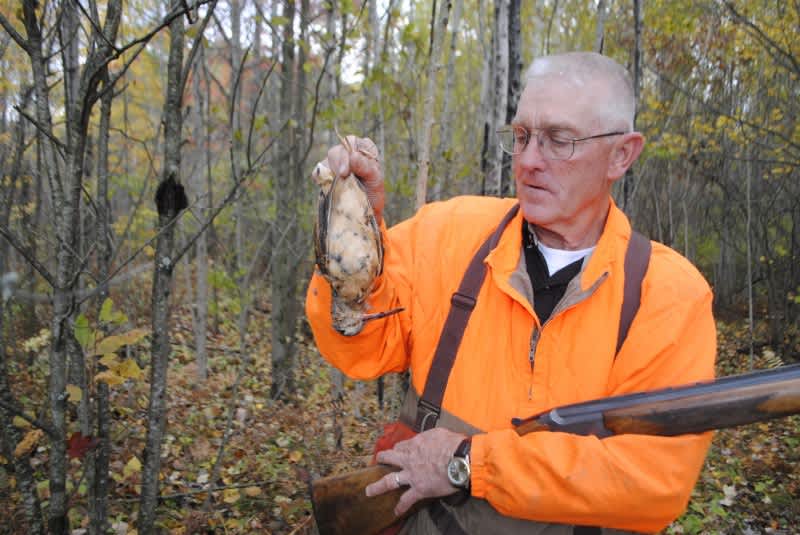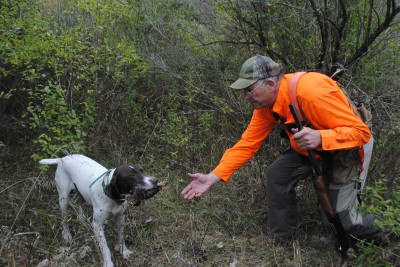Birds of the North Woods: Michigan Woodcock Hunting
Bob Gwizdz 10.30.13

Ask anyone; woodcock are birds of the north woods, right? So go North, young man.
But when you look at it from a more national, less Michigan-centric perspective, well, southern Michigan pretty much is the north woods, isn’t it?
I’ve been mulling this over in my mind for some time now and two recent hunts, both conducted well south of Clare, have solidified my feelings on the subject.
Just a little less than a week shy of the pheasant opener, I spent the better part of the day hunting with Chuck Riley, a pretty dedicated bird hunter who has championed southern Michigan woodcock for years. We started out northwest of Lansing (where Riley lives) and wound up northeast, hunting two different state game areas. The hunting was fine.
At our first spot, we put up nine woodcock in three hours—certainly not gangbusters, but a similar flush rate to what I’d recently experienced while hunting near Mio. And though I lost count of our flush rate at the next game area, it was of the same magnitude.
“Why should I drive 150 miles when I can kill a limit of woodcock within 50 miles?” Riley asked.
The guy has a point, eh?
Riley is active with the local chapter of the Ruffed Grouse Society, which is putting time and money into improving the woodcock habitat at a couple of southern Michigan game areas. He said, frankly, that southern Michigan woodcock have been too long ignored, while management efforts have been expended on other species.
Riley has plenty of ammunition to back up his perspective on the suitability of southern Michigan habitat for woodcock. Of the 65- to 80-something woodcock he bands each spring, 75 percent are found in southern Michigan, despite his regular soirees to the Houghton Lake area, he said. Similarly, despite a 10-day trip “Up North” this fall, he’s harvested the bulk of his birds from southern Michigan.

(Again, keep in mind that my hunt—and conversation—with Riley occurred before the October 20 pheasant opener.)
A few days after that, I spent a good part of a day hunting with retired Department of Natural Resources (DNR) wildlife biologist Jeff Greene just west of Mount Pleasant. Our flush rate was about the same as Riley and I had enjoyed. And over the course of our conversation, Greene mentioned that he’d seen nothing to indicate that any flight birds had moved into the area yet.
I called Greene back a few days after the pheasant opener and asked what he’d been seeing. He told me that a few days after our hunt, he and a buddy had moved 40 woodcock in two hours from the same general area. His conclusion? The migrants had arrived.
Over the years, I’ve enjoyed some excellent woodcock shooting while pheasant hunting in southern Michigan. You’d push to the end of the field and the dogs would keep going on into the woods where the newly arrived timberdoodles had taken up temporary residency, often in areas that were by no means classic woodcock habitat. Al Stewart, the upland game bird specialist at the DNR, has had similar experiences.
“You can find them not only along the edges of stream bottoms in the alders, but sometimes you find them in idle fields, where there’s goldenrod growing, for whatever reason,” said Stewart, who agrees that opening day of pheasant season seems to be about when the northern birds arrive. “It’s not switch grass; it’s kind of like finding them in bracken ferns. It’s cover over the birds, but at ground level they can see a long way.”
There are certainly some holes in our knowledge about woodcock migration. It is generally assumed that birds stage before migration—hence occasional flush rates of 20 birds an hour—yet they don’t tend to move together in huge flights like ducks, but rather in loose groups. And what causes them to get up and move around (Stewart reported a bird banded as a chick in the spring at Rose Lake just outside of Lansing had been killed at Houghton Lake the same fall) remains a mystery. We do know that they can move great distances overnight when they’re riding the leading edge of a norther. And a full moon, which sportsmen tend to believe is responsible for everything from goose migration to bass spawning, seems to play a role, too
But it’s clear that southern Michigan woodcock hunting is both misunderstood and sorely underappreciated. It ranges from good to outstanding, depending upon the timing.
Stewart, who is a pretty big woodcock fan himself, said sportsmen can expect more management initiatives to benefit southern Michigan woodcock in the future.
“We recognize the significance Michigan plays in continental woodcock management,” he said. “We have an opportunity—some might say a responsibility—to make a contribution.”
That ought to warm Chuck Riley’s heart.
It certainly does mine.
For more information on Michigan hunting go to michigan.org. Click here to purchase a Michigan hunting license online.

